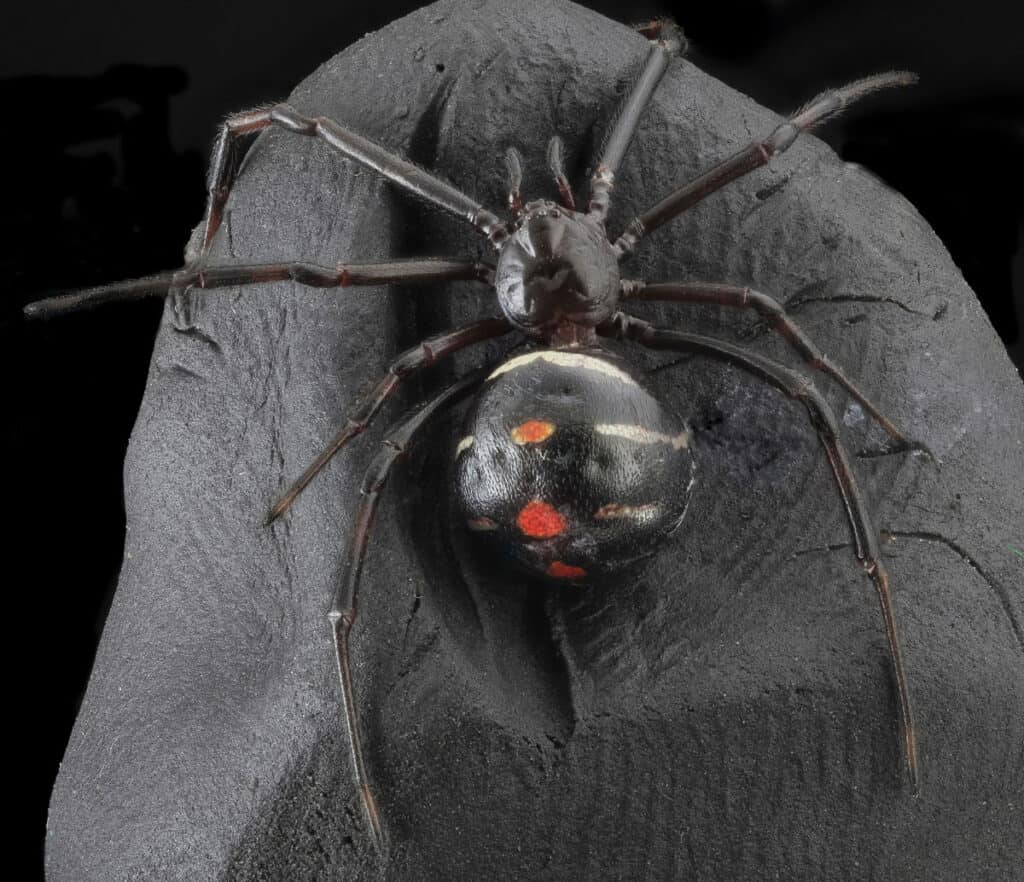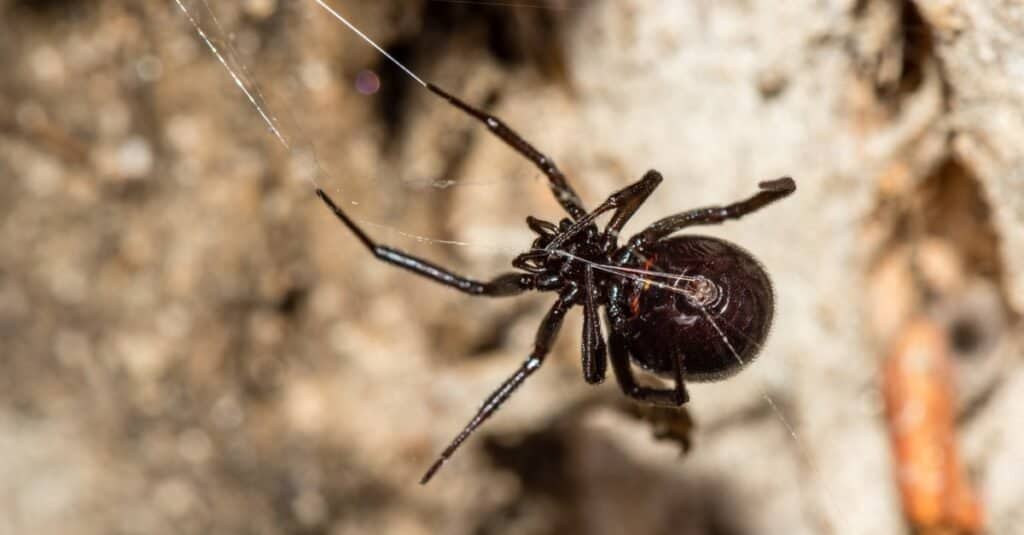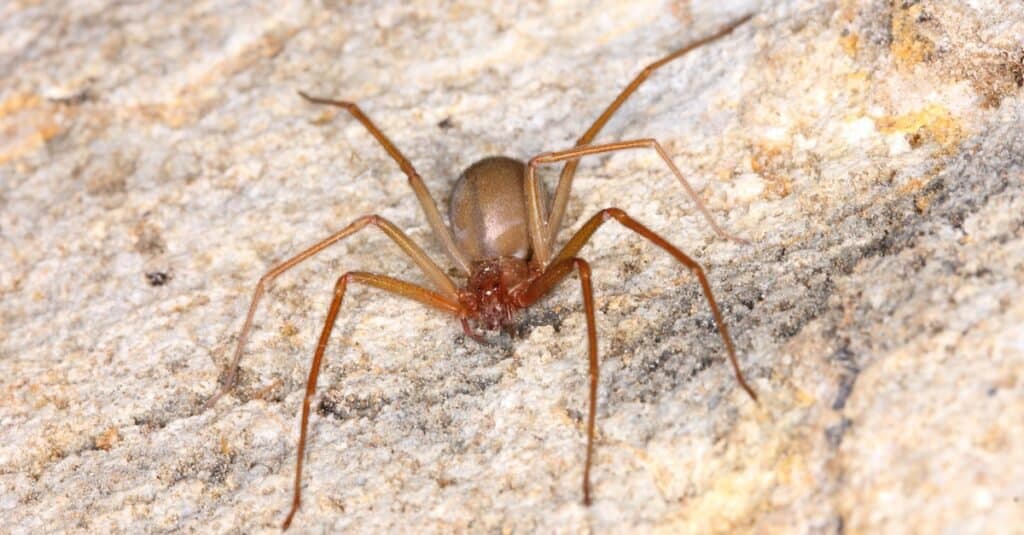Georgia’s subtropical and humid climate provides an ideal environment for numerous species of mammals, reptiles, amphibians, arachnids, and insects. Likewise, there are various species of spiders in Georgia –but not all of them should bother you. The vast majority of Georgia’s spiders are harmless species commonly found inside the homes and near human dwellings. Some of them are wolf spiders, common house spiders, and crevice spiders. While they can be a nuisance to have around, these spiders do not pose any significant threat to humans.
Even though most people use these terms interchangeably, spider bites are said to be venomous, not ‘poisonous’. An animal is referred to as poisonous if it can cause harm when eaten or ingested. But animals capable of introducing deadly toxins into the body through their bites are said to be venomous. Therefore, let’s explore the types of venomous spiders in Georgia and everything you need to know about them.
Venomous Spiders in Georgia
Southern Black Widow

The black widow spider is native to the southeastern part of the United States.
©Jeff W. Jarrett/Shutterstock.com
One of the most dangerous black widow species in Georgia, the southern black widow is native to the southeastern part of the United States. In the Savannah region of Georgia, the southern black widow is found both in the wild and around human dwellings. One interesting thing to note is that male and female spiders of this species look different. Female southern black widows are black and shiny, with a red marking in the shape of an hourglass on the underside of the globe-shaped abdomen. Males, though, are purple in color. Also, the females are predominantly larger than males. The body length of the mature female spider is about 0.51 inches and about 0.23 inches for males.
The venom of the southern black widow spider takes about ten minutes to take effect. It is highly toxic and majorly affects the nervous system. When bitten, the victim may feel intense pain, swelling, burning, and redness at the site of the bite. Some people may experience muscle cramping and stiffness, nausea, difficulty breathing, and severe abdominal pain. However, bites are rarely fatal to humans.
Northern Black Widow

Northern black widow spiders venom can be as potent as that of a rattlesnake.
©Porco_Rosso/Shutterstock.com
The northern and southern black widow spiders are close relatives, and both can be found in Georgia. Like the southern black widows, they’re shiny black and are easily recognized by the red hourglass markings on their abdomens. When you come across a northern black widow, you’ll identify it by a row of red spots down the middle of the upper surface of the abdomen with two crosswise bars on the underside. Northern black widows are also found in cool, dark places like under logs, stone walls, crawl spaces, and woodpiles.
Also one of the types of venomous widow species native to Georgia, northern widows are very deadly. Just like the southern widows, this spider’s venom can be as potent as that of a rattlesnake. Experts report that each northern widow spider contains about 0.254 mg of venom! The venom causes symptoms such as severe pain, abdominal cramps, muscle stiffness, excessive sweating, and hypertension. Though these spiders rarely bite, their bites are very deadly and may require urgent medical attention.
Brown Widow

Although the brown widow spider’s bite is painful, it is not considered dangerous.
©Decha Thapanya/Shutterstock.com
Another widow spider in the genus Latrodectus, the brown widow, is also a close relative to the popular black widow spider. Although it is slightly smaller in size and lighter in color than the black widow spider, the brown widow spider has unique black and white patterns on the sides of its abdomen as well as an orange-yellow colored hourglass shape. Like the black widow spider, the brown widow is frequently seen around homes and beneath porches. They build webs in secluded areas such as empty containers, storage closets, buckets, and garages.
Their bites, though painful, are not considered dangerous. In reality, they are usually much less dangerous than those of the black widow. Like all Latrodectus species, this spider has a neurotoxic venom. The effects of the toxin are usually confined to the bite area and surrounding tissue, causing pain and swelling in some cases. It is important to seek medical attention if any life-threatening symptoms are seen.
False Widow Spider

The false widow spider is dangerous to humans but not life-threatening as is the case with the black widow.
©Danie Spreeth Photography/Shutterstock.com
Though false widow spiders are spiders in the genus Steatoda, they resemble widow spiders, hence the reason they’re called “false widow spiders.” You can distinguish them from other spiders of the same genus by their large size and distinctive coloration. By physical appearance, the false widow spider has a brown bulbous abdomen with cream-colored markings, and its legs are reddish-orange. This species is spotted all year round in Georgia, both indoors and outdoors in different habitats including demolished buildings, around cacti, and roadside cuttings.
The false widow spider is considered a dangerous species in Georgia. When they bite, they release a highly toxic venom that causes the intense pain commonly reported. Symptoms also include feverishness or general malaise. This spider is also a common vector for pathogenic bacteria, carrying bacteria on its chelicerae and the surface of its body.
According to a study, twelve pathogenic bacterial species were isolated from an individual specimen. This shows that apart from opportunistic bacteria present on the skin, the spider bite itself can directly cause secondary infections.
Brown Recluse

The brown recluse spider is one of the deadliest spiders in the United States.
©Pong Wira/Shutterstock.com
A rare species in Georgia with limited distribution in the state, the brown recluse spider is found in 31 out of Georgia’s 159 counties, with almost all being found in the northern parts of the state. They’re almost completely absent in the southern portions.
Brown recluse spiders have a special preference for places that are dry and generally isolated such as woodpiles, sheds, cellars, closets, and garages. An adult specimen measures between 0.24 and 0.79 inches but some individuals may appear larger. With a light to medium brown appearance, these spiders usually have a black line on the dorsal side that looks like a violin and can be distinguished from other species of recluse spiders by the presence of six eyes arranged in pairs.
The brown recluse spider rarely bites and is considered non-aggressive because they generally avoid contact with humans. Bites occur only when the spider is accidentally pressed against the skin. Most victims experience symptoms such as nausea, vomiting, fever, rashes, and muscle and joint pain. The bite usually forms a painful, necrotizing ulcer that may take months to heal. The brown recluse spider is one of the deadliest spiders to man as its venom spreads throughout the body within minutes.
The photo featured at the top of this post is © Nick626/Shutterstock.com
Thank you for reading! Have some feedback for us? Contact the AZ Animals editorial team.






